A Vengeful, but Oddly Unsorrowful Belladonna
posted May 17, 2016 1 Comment
![]()
A restoration of a monument of Japanese anime film does it great honor, visually, and prompts some questions about representations of sexual assault, perpetrator presumption, and much else.

Eiichi Yamamoto’s 1973 animated Belladonna of Sadness has long been “simply the most beautiful and transcendent film I knew in proportion to both its obscurity, and the low quality of all known copies at the time,” says Hadrian Belove, co-founder and executive creative director of The Cinefamily.
So he and colleagues at the Los Angeles film organization have joined with rising distributor and “boutique” film lab Cinelicious and film producer SpectreVision (Elijah Wood’s outfit) to restore the film, which has variously been described as an “erotic horror film,” “a beautiful and disturbing x-rated animated fantasy” (Simon Abrams, Village Voice), a “stylized pandemonium” of “Joan of Arc pastiche, a musical, an exploitation picture, and a pornographic movie” (in the pinku style) that makes one imagine Hanna-Barbera had commissioned Hieronymus Bosch (J.W. McCormack, Vice), and “undoubtedly a landmark of animated film, and arguably a masterpiece” but “a very disquieting one” that is “compulsively watchable, even at its most disturbing” (Glenn Kenny, New York Times).
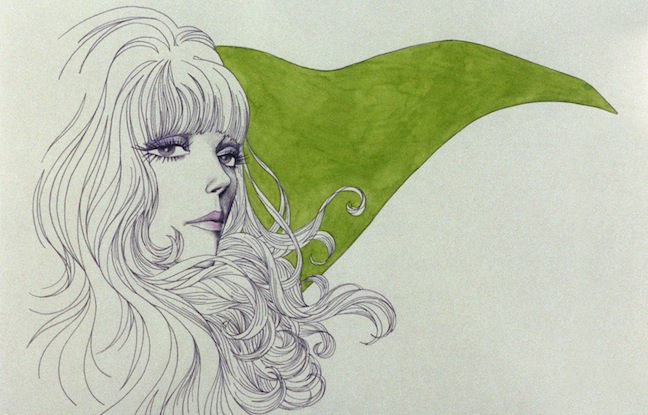
n
This week and next — 12-26 May, 2016 — Cinefamily is screening the high-quality 4K restoration of the rarely-shown 89-minute film, which when first made was not officially released in the United States. The restoration of Kanashimi no Belladonna, which is also known as Tragedy of Belladonna, is in the midst of a run of screenings around North America and in July will appear in home-video DVD and Blu-ray versions.
Glenn Kenny of the NY Times notes that the film’s makers drew on various graphic modes — “fashion magazines, pop art, psychedelia, underground comics, arty pornography, and much more” — to produce “dizzying” and “awe-inspiring” effects through “meticulously executed visual freakouts.” The visual accomplishment is all the more remarkable, given that Kanashimi no Belladonna was made with so tight a budget that even its director called it a “patchwork film” in his account of the history of Mushi Productions, which the “godfather of anime and manga,” Osamu Tezuka, founded, and which earlier produced the iconic (and altogether other-kettle-of-fish) Astro Boy and Kimba the White Lion. Mushi was behind the singular Kanashimi no Belladonna and two earlier reworkings of literary works, A Thousand and One Nights and Cleopatra; the three films comprised the not-for-kids-animation suite, Animerama. Mushi then went broke.
{Click on an image to expand}
n
Belladonna of Sadness draws from Jules Michelet’s speculative history of witchcraft and its travails, La Sorcière, published in 1862 and then in English translation (below), a year later. The Mushi adaptors riffed on it, and its sensationalism, in depicting a young woman who during some vaguely medieval time is raped by a feudal baron exacting “droit du seigneur” (whose historical reality is disputed, although for Belladonna of Sadness’s depiction of male presumption, that’s not particularly here nor there). Shunned by her village, Jeanne enters into a pact with an evil-imp penis homunculus — Satan, or someone of that ilk — and exacts revenge.
{Click on an image to expand}
Cinefamily’s Hadrian Belove says Belladonna of Sadness has long been “the film I personally wanted to see in its original form and splendor, a film I loved sharing with others, and wanted the world to discover; it was a cult film waiting to happen, a cult film that needed to happen.” Thanks to the enthusiasm of the restoration project’s personnel, technicians were able to obtain the original 35mm camera negative and sound elements from Mushi Productions (it survived its 1973 financial collapse, to rise again), and also to include more than eight minutes of footage, including a surreal “explicit” orgy scene, that had been cut from the negative but left on a print that made it to Belgium.
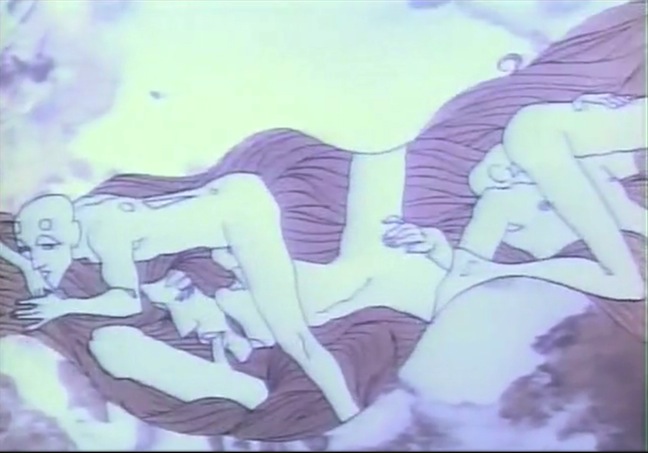
n
As for the quality of the restoration, Cinefamily’s Hadrian Belove boasts, and early reviews have borne him out: “Some frames revealed themselves to be not just drawings, but dazzling hand-painted watercolors, complete with all the spreading, subtle gradations of the form; in other frames, you could see pieces of paint left on the image for textural effect. I realized that in the previous blurry bootlegs we’d all seen, one couldn’t even tell what medium the drawings were.”
Here’s the trailer for the restoration:
And here, for good measure, is the trailer for the original, 1973, Japanese release:
Many aspects of the film, fecund with organic rot, lend themselves to hyperbole, as in a publicity copywriter’s wet dream. The restoration producers’ pitch material has a cult-fannish flavor when it speaks of the film as “one of the great lost masterpieces of Japanese animation,” an “LSD-stoked 1970s head trip,” a “mad, swirling, psychedelic light-show of medieval tarot-card imagery with horned demons, haunted forests, and La Belle Dame Sans Merci, equal parts J.R.R. Tolkien and gorgeous, explicit Gustav Klimt-influenced eroticism.” The publicity material similarly extols “spectacular watercolor paintings by Kuni Fukai” that “marry the art nouveau artifice of artists like Aubrey Beardsley to ’60s psychedelia.”
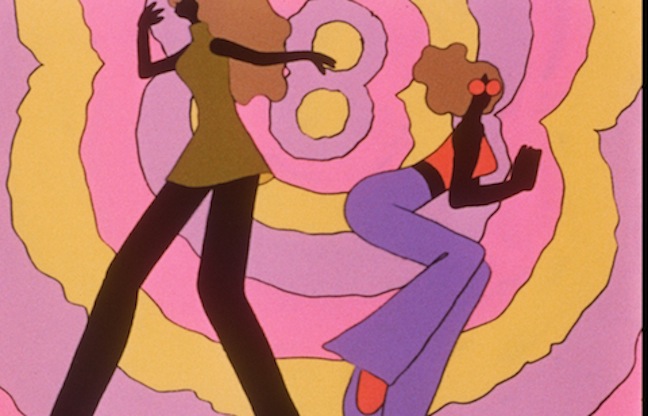
n
But, the quality of the restoration, aside, reviewers and critics have expressed reservations about the film. Simon Abrams, in Village Voice, wrote: “You can’t easily ignore the filmmakers’ cavalier attitude toward rape. Jeanne’s…frequent violation by the Devil…is initially presented as spank-bank material in misogynistic sex scenes that emphasize the possession and destruction of Jeanne’s body. … What you get out of these violent sex scenes — like when Jeanne’s body is briefly transformed into a blood-red puddle of shape-shifting curves and orifices — depends on whether you choose to see Jeanne as a tormented martyr or a series of ravishing drawings. You could marvel at the animators’ draftsmanship during slow tracking shots that highlight her flowing mane and jutting profile. Or you might get stuck on how cartoonishly oversexed she often is. Jeanne’s frequent gasps make her sound like an orgasm-prone asthmatic, and her ever-gaping mouth makes her look like a ventriloquist’s dummy.”
To be sure, this response contrasts with some others. Rolling Stone gushed the fanboy party line. And in her 2010 book, Anime and the Art of Adaptation: Eight Famous Works from Page to Screen, Dani Cavallaro argued that “although Jeanne’s violation is horribly traumatizing, it also carries epiphanic connotations insofar as it is instrumental in the character’s awakening not only to her dormant carnal longings but also to her true nature — thus far occluded by an enforced veneer of languid submissiveness — as an imaginative, free-willing, rebelliously resourceful and inquisitive soul.”
In other words, being raped propels her to blossom into her true self.
How fortunate for her.
Similarly, in a September 2015 review in The Daily Beast, Jen Yamago proposed that “Joan of Arc tragedy-triumph meets 1970s Japanese art house transgression” in the “long-forgotten X-rated psychedelic animation gem about one woman’s violation, persecution, and sexual awakening.” Since its initial screenings, she writes, the film’s devotees, “obscure art fiends and animation hounds,” have prized it for “its striking visuals, brutal violence, and explicit sexuality, folded into a boldly controversial feminist narrative.”
It’s not clear what that says about the “obscure art fiends and animation hounds.” And, “feminist credentials”?
Satan, Yamago explains, first appears “as a flirty phallic imp” who “grows in size and intensity proportionate to his mounting desire to possess” Jeanne, but his raping her “leads to a financial and sexual liberation that begins spreading to her fellow commoners, much to the dismay of the morally bankrupt religious-political order.” In this way, says Yamago, the film, although “brutal,” “pays tribute to so-called witches of medieval times as the forebears of modern feminist revolutionaries.”
That contention might well have been contemplated by Eiichi Yamamoto, but its development within the film is so incoherent, and so entangled in frankly odious notions, that it’s hard to know where to start, to address it. One might observe that the historical literature about early-modern witchcraft trials in no way bears out Yamamoto’s reading – or, rather, the spin his frightful muddle evidently imparts on some entranced in its ghastly vortex.
But, oh, says the publicity material, the “not for the easily offended” film is “transgressive.” Well, it’s something of the kind — what else could a film be, where the victim of rape by a demonic figure recovers sufficiently in about a minute of the film’s that she can giggle while stimulating a flaccid schmeckel of a devil to functional swell, and curling her toes with voluble gratification.
Recovery is that easy!
That cartoonish sexualization of Jeanne that Simon Abrams notes in Village Voice cries out for analysis. Yamamoto represents the savaged woman as an erotic naïf: a hippie-chic, late-1960s English fashion model, or a sylph out of some Alphonse Mucha print. That characterization persists even while he subjects her erratically to the measured, purposeful, bracing sexuality of Gustav Klimt and the Vienna Succession, and to the contortions chiseled from flesh by Klimt’s student, Egon Schiele. Flopping all over the shop, Yamamoto flips back a century to summon the riveting grotesques of Francisco Goya’s warscapes from his Peninsula-campaigns-inspired Disasters of War series, or the charnel-house slaughter of his Black Paintings series.
Reviewers and critics have already remarked most of these influences and allusions, but a key issue, when assessing Yamamoto’s deployment of them all, is this: how aware were he and his collaborators of the force and meaning of all the allusions, and how much control did they have of their significations? In fact, how much responsibility were they inclined to take for the deployment of all these flailing moving parts? Were they content to indulge an orgy of cultural representations?
Indeed, among the film’s bravura set-piece sequences is an orgy transacted along braids of Jeanne’s hair, erotic particularly if you can bar from your mind the participants’ pestilential appearance.
The central supposedly erotic presence and experience is Jeanne’s — it’s so powerful that, as Jen Yamago rejoices in The Daily Beast, it seeps into the consciousness and libido of Jeanne’s fellow serfs, even as the lord and his religious cohorts burn Jeanne to death. (That happens, predictably enough, on a crucifix, as Yamamoto ham-fistedly stitches together two modes of Judeo-Christian-Western dispatch of its pariahs.)
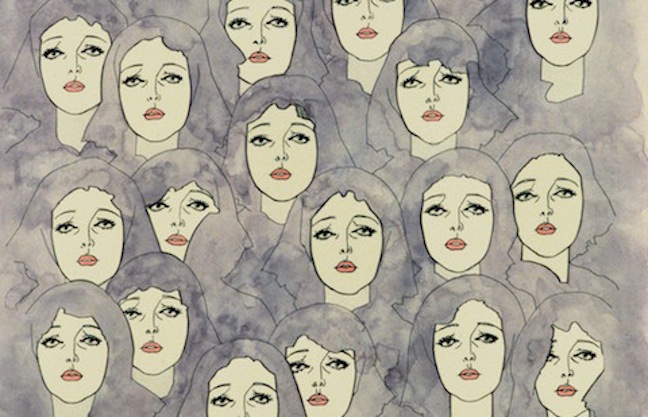
The serf women brighten, infected by Jeanne’s abandon. Pity she’s burning on a crucifix, as their outlook improves.
n
As Jeanne is splayed, invaded, and brutalized, he has her also comply, giggle, arouse, open-mouthed about heavily-rouged lips. Through all her torment, and even the torrid orgy of sex and wreaked revenge, she never loses her eyeliner. (Yes, big eyes and small mouth is part of the anime aesthetic, but that doesn’t relieve them of their significations.) Even as she is burned on a crucifix, scarlet smoke licks about her naked body, which remains as naif-sexualized as ever. Just to increase suspicions that Yamamoto has little control over the cultural motifs and tropes he deploys, the music during one climactic sequence is a gallimaufry of Laurence Welk-lite (sapristi!), heavily aspirated and cooed Europop, dull rock opera, and spaghetti western sardonicism… Again, that uncontrolled muddle of influences. Weird.
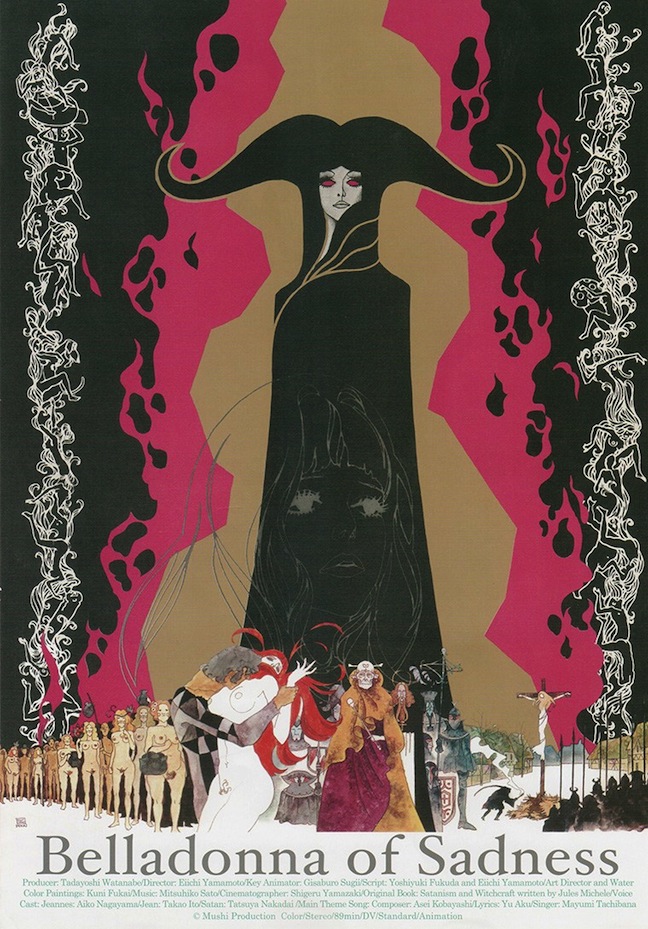 All that, and the key issue of agency. Yamamoto’s idea of agency seems to be to have Jeanne comply, scream, and moan, whether in orgies of grand guignol subjection or lust — to respond to her ordeal and engulfment in evil in ways that sophomoric voyeurs might wish to gaze upon and consume. More than anything, frankly, the film inscribes the psychopathology of carnal assault. Yamamoto savages his heroine at his film’s outset, and then indulges sophomoric male fantasies, including the one in which a man liberates a woman by enabling her to profit and obtain revenge from being raped.
All that, and the key issue of agency. Yamamoto’s idea of agency seems to be to have Jeanne comply, scream, and moan, whether in orgies of grand guignol subjection or lust — to respond to her ordeal and engulfment in evil in ways that sophomoric voyeurs might wish to gaze upon and consume. More than anything, frankly, the film inscribes the psychopathology of carnal assault. Yamamoto savages his heroine at his film’s outset, and then indulges sophomoric male fantasies, including the one in which a man liberates a woman by enabling her to profit and obtain revenge from being raped.
“Transgressive” works of art are not immune to unpacking, and sometimes the transgression turns out to be largely aggression, presumption, or an artistic and intellectual dog’s dinner. You could argue that Yamamoto’s gesture towards Jeanne — towards whomever or whatever demography he intends her to represent — essentially is this: I’ll have Satan rape you, but that’ll make you strong and sexually empowered, and I’ll work things so you can wreak revenge, too.
J.W. McCormack contends, in Vice, that “Belladonna of Sadness is deserving of a place in the cultural memory because it marks the moment when the Times Square porn groove met manga cuteness, and because it happens to function as an omnibus of 20th century modes, including that of the Impressionist watercolor, the fuzzy Kandinsky-esque geometric dissolve, and the prog-rock album sleeve.”
Stick in the memory, no doubt; certainly many elements of it should stick in the craw.
— Peter Monaghan
Released simultaneously with the restoration is Belladonna of Sadness, a large-format, full-color, limited-edition companion book from publisher Hat & Beard. It includes script outtakes, stills, and other ephemera from the film, a description of the film’s painstaking restoration, and interviews conducted with film’s crew members, including director Eiichi Yamamoto. It also is available in a Limited Edition version, which additionally includes the Cinelicious Pics’ Blu-ray release of the restoration and two U.S. theatrical posters.
Previous Post: How to Break into Movies — in 1907
Next Post: 39 Institutions Receive Preservation Grants




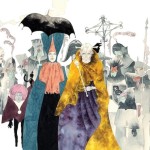
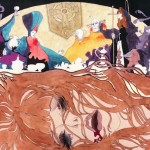










While I appreciate the opinions, views, and issues this essay brings up (the misogyny, seemingly taking violation light-heartedly, or at least putting it on the back burner) I believe treating the film as anything other than allegory negates those aspects of the story, and undeniably beautiful artwork, intended to convey not some type of historical account, but a map of the situation a beautiful woman’s life would be trapped in at a time in history where Judeo-Christianity reigned supreme. In the mass rape Jeanne endured, as well as her husband’s devastating reaction to her trauma, I found her response to the devil’s appearance both evidence of her inherent independence, and a defiant reclamation of a budding sense of self. Her sexuality belongs to her alone, not to be held hostage to a violation she had nothing to do with. The devil sees the actualized self in her she has not yet discovered and encourages her to explore and nurture it. Life is intolerably cruel to her, and the life she creates for herself is in response to that cruelty and her own inner self. Her husband, whom she clearly loves, is a mere secondary character, overshadowed by her strong personality. The devil’s response to her feelings that she should look as old and hideous on the outside as she feels on the inside proclaims her life experience and personal growth has made her “more beautiful than god”. Her eventual execution punctuated her uncompromising dedication to her own principles. I saw the historical inaccuracies as irrelevant to the feelings meant to be evoked, art transcending accuracy. It is an ugly reality that women are punished for their mere gender, for their independence in the face of societal pressures to conform, for demanding that they alone own themselves and their sexual power.
I think perhaps the Japanese point of view, the Eastern lack of pervasive Christian taint, did the story more justice than Western eyes could have conveyed. Women have historically been punished for their independence and sexuality in biblical tradition that has proved hard to scrub away, even as feminist doctrine attempts to rectify these ills. I have yet to read La Sociere, but look forward to comparing the source material to the film.